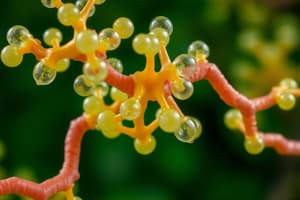Podcast
Questions and Answers
What does the development of blue-green fluorescence indicate in the Fluorescence Test for Coumarin Glycosides?
What does the development of blue-green fluorescence indicate in the Fluorescence Test for Coumarin Glycosides?
In the Sodium Picrate Test for Cyanophoric Glycosides, what causes the formation of a brick red color?
In the Sodium Picrate Test for Cyanophoric Glycosides, what causes the formation of a brick red color?
What is indicated by the formation of a yellow spot on a filter paper in the Ammonia Test for Flavonoid Glycosides?
What is indicated by the formation of a yellow spot on a filter paper in the Ammonia Test for Flavonoid Glycosides?
What color change indicates the presence of dihydro flavonoids in the Shinoda Test for Flavonoid Glycosides?
What color change indicates the presence of dihydro flavonoids in the Shinoda Test for Flavonoid Glycosides?
Signup and view all the answers
Which reagent is responsible for the pink color formation in the Vanillin HCl Test for Flavonoid Glycosides?
Which reagent is responsible for the pink color formation in the Vanillin HCl Test for Flavonoid Glycosides?
Signup and view all the answers
What causes the development of blue-green fluorescence in the Fluorescence Test for Coumarin Glycosides?
What causes the development of blue-green fluorescence in the Fluorescence Test for Coumarin Glycosides?
Signup and view all the answers
What role does sodium picrate solution play in the Sodium Picrate Test for Cyanophoric Glycosides?
What role does sodium picrate solution play in the Sodium Picrate Test for Cyanophoric Glycosides?
Signup and view all the answers
Which component reacts with ammonia vapor in the Ammonia Test for Flavonoid Glycosides resulting in a yellow spot?
Which component reacts with ammonia vapor in the Ammonia Test for Flavonoid Glycosides resulting in a yellow spot?
Signup and view all the answers
Study Notes
Chemical Tests for Glycosides
Tests for Anthraquinone Glycosides
- Borntrager's test: Add 1 gm of drug to 5-10 ml of dilute HCl, boil on water bath for 10 min, and filter. Extract with CCl4/benzene, add equal amount of ammonia solution, and observe for pink or red color formation.
- Modified Borntrager's test: Add 1 gm of drug to 5 ml of dilute HCl, followed by 5 ml of Ferric chloride (5% w/v). Boil for 10 min, cool, filter, and extract with CCl4/benzene. Add equal volume of ammonia solution and observe for pink to red color formation.
Tests for Saponin Glycosides
- Hemolysis test: Mix a drop of blood on a slide with a few drops of aq. saponin solution. Observe for RBCs rupture in the presence of saponins.
- Foam test: Add 1 gm of drug to 10-20 ml of water, shake for a few minutes, and observe for frothing that persists for 60-120 s.
Tests for Steroid and Triterpenoid Glycosides
- Libermann Burchard test: Evaporate an alcoholic extract of the drug to dryness, extract with CHCl3, add a few drops of acetic anhydride, and then conc. H2SO4. Observe for violet to blue-colored ring formation.
- Salkowski test: Evaporate an alcoholic extract of the drug to dryness, extract with CHCl3, add conc. H2SO4, and observe for yellow-colored ring formation that turns red after 2 min.
Tests for Cardiac Glycosides
- Keller-Kiliani test: Add equal volume of water and 0.5 ml of strong lead acetate solution to an alcoholic extract of the drug. Filter, extract with chloroform, and add FeCl3 solution. Observe for reddish-brown layer formation that turns bluish-green after standing.
- Legal test: Add equal volume of water and 0.5 ml of strong lead acetate solution to an alcoholic extract of the drug. Filter, extract with chloroform, and add pyridine and sodium nitroprusside solution. Observe for pink color formation.
- Baljet test: Dip a thick section of a leaf of digitalis or the part of the drug containing cardiac glycoside in sodium picrate solution. Observe for yellow to orange color formation.
Tests for Coumarin Glycosides
- Ferric Chloride test: Add a few drops of alcoholic FeCl3 solution to a concentrated alcoholic extract of the drug. Observe for deep green color formation that turns yellow on addition of conc. HNO3.
- Fluorescence test: Mix an alcoholic extract of the drug with 1N NaOH solution. Observe for blue-green fluorescence.
Tests for Cyanophoric Glycosides
- Sodium picrate test: Moisten the powdered drug with water, add a few drops of conc. sulfuric acid, and trap filter paper impregnated with sodium picrate solution followed by sodium carbonate solution. Observe for brick red color formation.
Tests for Flavonoid Glycosides
- Ammonia test: Expose filter paper dipped in an alcoholic solution of the drug to ammonia vapor. Observe for yellow spot formation.
- Shinoda test: Add magnesium turning and diluted HCl to an alcoholic extract of the drug. Observe for red color formation. Add zinc turning and diluted HCl to an alcoholic extract of the drug. Observe for deep red to magenta color formation.
- Vanillin HCl test: Add vanillin HCl to an alcoholic solution of the drug. Observe for pink color formation.
Studying That Suits You
Use AI to generate personalized quizzes and flashcards to suit your learning preferences.
Description
This quiz covers different chemical tests used to detect various types of glycosides such as anthraquinone, saponin, steroid, triterpenoid, cardiac, coumarin, cyanophoric, and flavonoid glycosides. It also includes information on specific tests like Borntrager’s test and Modified Borntrager’s test.




